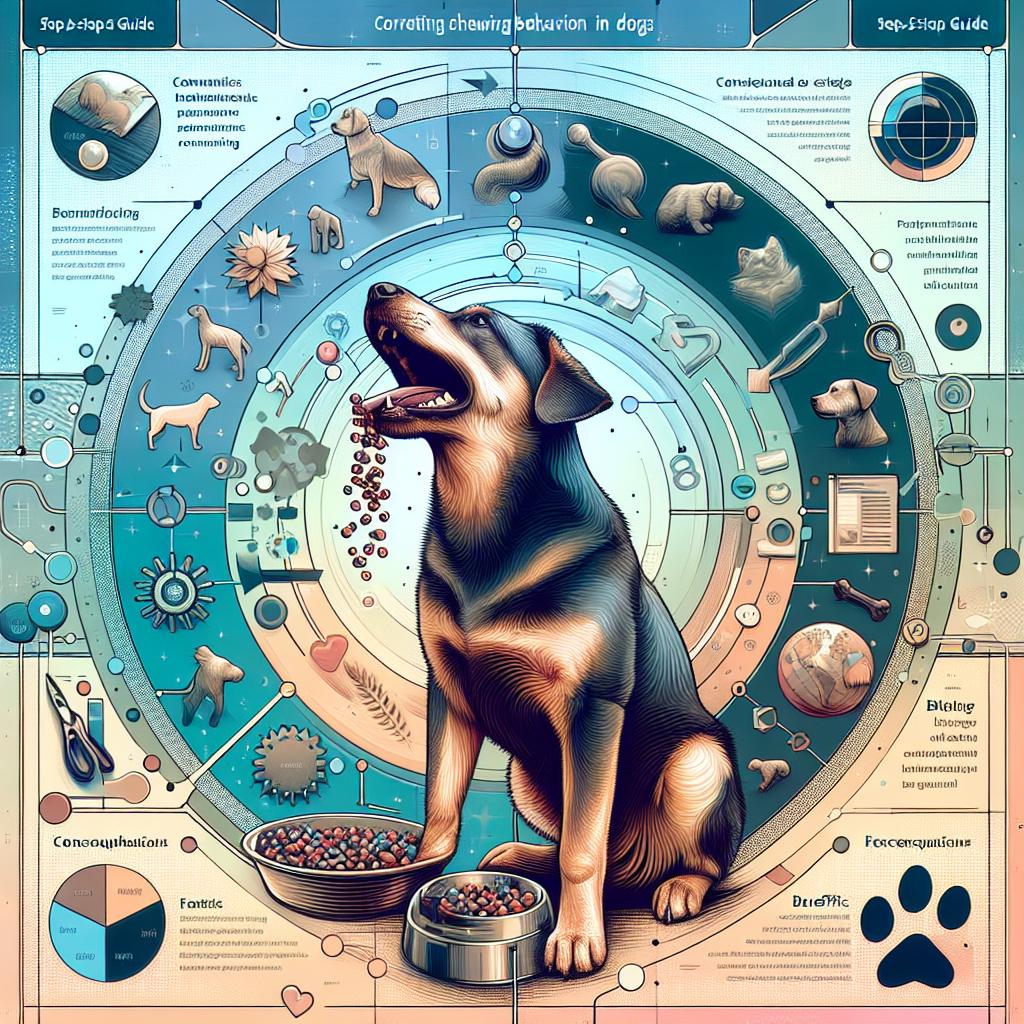Introduction
Dogs, our loyal companions, often express their curiosity and emotions through their chewing behavior. While it’s natural for them to explore the world with their mouths, excessive or destructive chewing can pose a challenge for pet owners. Whether it’s your favorite pair of shoes, an important piece of furniture, or the pesky habit of chewing on their own paws, understanding and correcting these behaviors is essential for maintaining harmony in the home and ensuring the well-being of our furry friends. In this article, we will provide a comprehensive step-by-step guide to help you address problematic chewing behaviors in dogs. From identifying the underlying causes to implementing effective training techniques, our approach aims to create a balanced and happy environment for both you and your four-legged family member. Join us as we delve into the world of canine chewing habits and discover the tools you need to foster positive behaviors in your beloved pet.
Understanding the Root Causes of Chewing Behavior in Dogs
Understanding why dogs chew involves delving into their natural instincts and behavioral traits. Many factors influence chewing behavior, from age and breed to environmental influences. Puppies, for instance, often chew to relieve teething discomfort and to explore their surroundings, while adult dogs may chew out of boredom, anxiety, or as a way to seek your attention. Recognizing these underlying motivations can be crucial for addressing and correcting unwanted chewing habits. Paying attention to when and where the chewing occurs can reveal a lot about what might be triggering your dog’s behavior.
To effectively tackle chewing issues, it’s essential to consider different approaches, tailored to the root cause. For example:
- Provide appropriate chew toys: Ensure your dog has engaging chew toys that are safe and suitable for their age and size.
- Increase exercise: Regular physical activity can help burn excess energy and reduce boredom.
- Address anxiety: If your dog’s chewing stems from separation anxiety, gradually training them to feel comfortable alone may help.
- Redirect behavior: When you catch your dog chewing on something inappropriate, redirect them to their designated toys.
Understanding and addressing the motivation behind your dog’s chewing can lead to more effective corrective measures, turning destructive habits into positive chewing behaviors.

Identifying Safe and Appropriate Chew Toys for Your Dog
Choosing the right chew toys for your dog is crucial not only for their enjoyment but also for their safety. When selecting toys, consider the following factors to ensure the product is suitable:
- Material: Opt for toys made from durable, non-toxic materials. Rubber and nylon are often safe choices, whereas soft plastic can splinter and pose a risk.
- Size: The toy should be appropriately sized for your dog. A toy too small can be swallowed, while one too large may be difficult for your pet to handle.
- Durability: Look for toys designed for aggressive chewers. Reviews and recommendations can guide you to the best choices available.
- Interactive Features: Consider toys that engage your dog mentally, such as puzzle toys or those that dispense treats when chewed.
To further assist in your selection process, here’s a quick comparison of popular toy types:
| Toy Type | Durability | Best for |
|---|---|---|
| Rubber Toys | High | Power Chewers |
| Nylon Bones | Medium | Moderate Chewers |
| Soft Plush Toys | Low | Gentle Chewers |

Implementing Training Techniques to Discourage Unwanted Chewing
To effectively discourage unwanted chewing behaviors in dogs, it’s crucial to implement positive reinforcement techniques. Start by identifying the items your dog is drawn to and ensure they are kept out of reach. Whenever your dog chooses to chew on appropriate toys instead, reward them with praise or small treats. This helps your dog associate good behavior with positive outcomes. Establishing a routine that incorporates playtime with designated chew toys can channel their energy in the right direction.
Another effective approach is utilizing deterrent sprays that are safe for pets. These sprays, which have a bitter taste, can be applied to furniture or objects you wish to protect. Here’s a simple table to help you choose the right deterrent method:
| Deterrent Method | Description | Effectiveness |
|---|---|---|
| Deterrent Spray | Bitter-tasting spray on prohibited items | Moderate to High |
| Noise Deterrents | Sounds triggered when chewing occurs | Variable |
| Redirecting Attention | Offering a toy when chewing is observed | High |
Consistency is essential; by robustly engaging with these methods, you can create a lasting understanding for your dog that good behavior is rewarded, while destructive chewing has clear consequences. Remember to keep the training sessions short and enjoyable to maintain your dog’s interest and enthusiasm.

Establishing a Consistent Routine for Positive Chewing Habits
Creating a structured daily routine for your dog not only promotes positive chewing habits but also enhances their overall well-being. Dogs thrive on predictability, and establishing a consistent schedule helps them understand when it’s time to play, eat, and relax. To foster these positive behaviors, consider implementing the following strategies:
- Set Meal Times: Feed your dog at the same times each day to create a sense of stability.
- Regular Play Sessions: Schedule short, engaging playtimes that allow your dog to expend energy and avoid alternative chewing.
- Calming Down Time: Allocate specific periods for quiet resting, which aids in reducing anxiety-driven chewing.
Additionally, using designated chew toys during these scheduled activities can help redirect your dog’s chewing tendencies. Choose safe and engaging options that match your dog’s chewing style. Consistently offering these toys as a reward after desirable behaviors will reinforce good chewing choices:
| Chew Toy Type | Best For | Recommended Duration |
|---|---|---|
| Rubber Toys | Aggressive Chewers | 30 mins daily |
| Soft Plush Toys | Gentle Chewers | 1 hour daily |
| Edible Chews | All Dogs | As per size and health |
Q&A
Q&A: Correcting Chewing Behavior in Dogs – A Step-by-Step Guide
Q1: Why do dogs chew, and is it a natural behavior?
A1: Absolutely! Chewing is a natural instinct for dogs, serving various purposes such as relieving boredom, easing anxiety, exploring their environment, or even teething. Understanding that chewing is inherent to canine behavior is the first step in addressing any problematic chewing habits.
Q2: What signs might indicate that my dog’s chewing behavior is problematic?
A2: If your dog is chewing destructively, such as tearing apart furniture, shoes, or other household items, or if they seem to be chewing excessively to the point of injury, it’s time to intervene. Look for signs like a constant focus on chewing, obsessive behavior, or distress when they chew.
Q3: How do I determine the right approach to correct my dog’s chewing behavior?
A3: Start by identifying the cause behind your dog’s chewing. Is it boredom, anxiety, or simply a lack of appropriate chew toys? Understanding the root of the behavior will help you tailor your approach effectively.
Q4: What steps can I take to redirect my dog’s chewing habits?
A4: Here’s a simple step-by-step:
- Increase Exercise: A tired dog is less likely to chew out of boredom. Ensure your pup has plenty of physical and mental stimulation through walks, playtime, and interactive toys.
- Provide Appropriate Alternatives: Invest in durable, engaging chew toys and encourage your dog to use them instead of household items. Rotate toys regularly to keep things interesting.
- Use Deterrents: Apply dog-safe bitter sprays to items you want to protect. When your dog attempts to chew these items, they’ll get an unpleasant surprise and learn to avoid them.
- Positive Reinforcement: Praise and reward your dog for chewing appropriate items. This helps them associate positive feelings with their toys rather than your furniture.
- Monitor Stress Levels: If anxiety seems to drive your dog’s chewing, consider consulting a veterinarian or a professional dog trainer for strategies to help alleviate stress.
Q5: How long should I expect it to take to correct my dog’s chewing behavior?
A5: There’s no one-size-fits-all answer, as each dog is unique. Some may adjust quickly, while others may take weeks or months. Consistency, patience, and ongoing positive reinforcement are key to long-term success.
Q6: Can certain dog breeds be more prone to destructive chewing?
A6: Yes, some breeds are naturally more energetic or have stronger instincts to chew than others. For example, working breeds and terriers are often more prone to chewing due to their high energy levels. Tailoring your approach to your dog’s breed traits can help address specific needs.
Q7: When should I consider professional help for my dog’s chewing behavior?
A7: If you’ve tried various techniques and your dog’s chewing continues to escalate or is accompanied by signs of distress or aggression, it may be time to seek help from a professional trainer or a veterinary behaviorist. They can provide personalized advice and support for both you and your pup.
Q8: What should I avoid doing when correcting my dog’s chewing behavior?
A8: Avoid punitive measures, such as yelling or using physical reprimands, as these can lead to fear-based responses and exacerbate anxiety. Instead, focus on encouraging positive behaviors and setting clear boundaries in a gentle manner.
Q9: How can I maintain the progress once my dog’s chewing behavior improves?
A9: Continue to provide stimulating activities and appropriate chew options even after improvement. Regularly engaging your dog both physically and mentally will help keep chewing behaviors at bay while strengthening your bond together.
Q10: Any final tips for dog owners struggling with chewing issues?
A10: Always remember that patience is vital. Celebrate small victories, and don’t hesitate to reach out to a community of fellow dog owners or trainers for support and shared experiences. Your dedication to understanding and correcting your dog’s chewing behavior can lead to a happier, healthier pet.
The Way Forward
correcting chewing behavior in dogs is a journey that requires patience, understanding, and a touch of creativity. By employing the strategies outlined in this guide, you pave the way for a harmonious coexistence with your furry companion. Remember, each dog is unique, and what works for one may not work for another, so stay observant and adaptable in your approach.
As you embark on this path, embrace the small victories—whether it’s a moment of focused attention on an appropriate chew toy or a successful redirection from forbidden items. With time, consistency, and love, you will nurture not just better chewing habits, but also a deeper bond with your dog.
So, gather your tools, channel your inner dog whisperer, and embark on this rewarding endeavor. Your patience and dedication will surely be rewarded with a more balanced and happy canine companion. Happy training!

